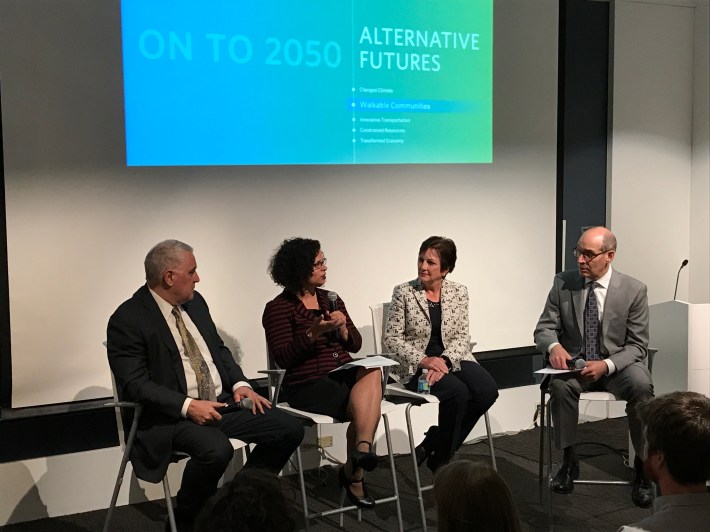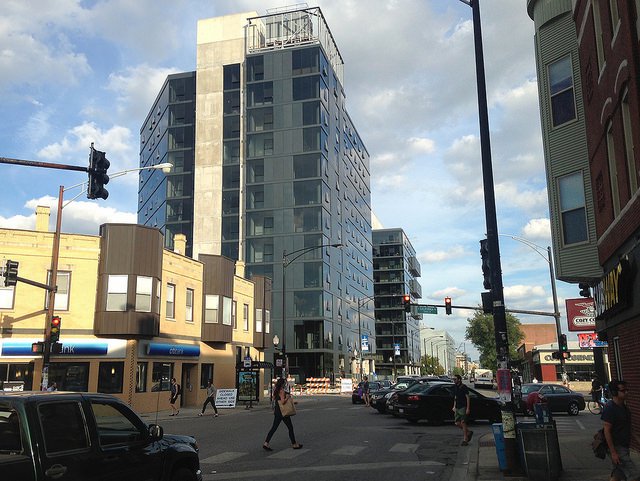As part of the process for developing ON TO 2050, the next comprehensive plan for the region, slated for adoption in October 2018, the Chicago Metropolitan Agency for Planning is hosting a series of forums on five “alternative futures” factors that could shape the region over the coming decades. These include changed climate, innovative transportation, walkable communities, transformed economy, and constrained resources.
A panel held last week at the Chicago Architecture Foundation called “Where We’ll Live in 2050” focused on the issue of walkability. The speakers all agreed that in the future more and more people in the region will prioritize living where it’s convenient to access jobs, education, healthcare, goods and services, and recreation without driving.
Much of the discussion focused on the question of equity. As communities where walking, biking, and transit are convenient become increasingly desirable, making sure that low-income and working-class people aren’t priced out of these areas, so that more residents can reap the health and economic benefits of walkability, will be a challenge.
The CAF event was moderated by WTTW host Geoffrey Baer, and featured Tom Kirschbaum from Jones Lang LaSalle, Linda Searl from Searl Lamaster Howe Architects, who also serves on the Chicago Plan Commission, and Joanna Trotter, who leads grant making in support of equitable development for The Chicago Community Trust. (The Trust is a Streetsblog Chicago funder.)
At the start of the talk CMAP executive director Joe Szabo said that a study found that 42 percent of baby boomers and 63 percent of Millennials want to live in a place where they don’t have to own a car. “The challenge is, as walkable places are in high demand, will that make them less affordable,” he said.
This issue has already come to a head in neighborhoods like Logan Square, where walkability and access to the Blue Line has spurred a boom in parking-lite transit-oriented developments along Milwaukee Avenue. While dense, low-parking housing near train stations is smart urban planning, almost all of the new buildings are upscale apartment or condo towers with high rents, which has led to a fierce debate over whether the TOD trend is accelerating the displacement of poor and working-class residents.
Kirschbaum, the real estate professional, jokingly described himself as “an evil capitalist,” but said he said he loves cities, and has been excited to see increasing interest in urban areas that many saw as undesirable not so long ago. “The issue of gentrification is a high-class problem from where I come.”
“To me it’s not a question of whether there will be walkability, but who gets access to these spaces,” said Trotter, who trained as an urban planner. “Walkability is about us being able to meet in common places.”

“Aren’t a lot of [lower-income] communities already walkable?” asked Baer.
Trotter responded that there’s a question of whether there are any destinations to walk to in a neighborhood. Orginally from Portland, Oregon, she said that she and her husband chose to live in Chicago's South Shore, a mostly African-American neighborhood on the South Lakefront. Although the layout of the neighborhood is walkable and the Metra Electric Line provides rail access, they have limited retail choices within walking distance, and prices at neighborhood stores are often higher than elsewhere in the city.
Trotter added that, because the Chicago Public Schools are badly underfunded, they pay to send their children to private school. “A family in Winnetka gets that kind of education for free” via well-funded public schools, she said. “We’re paying the ‘Black Tax’ because of where we live.”
Baer asked the panelists how we can lay the groundwork so that vulnerable groups benefit from walkable communities in the future. “Equity has to be front and center,” Trotter responded. “[Development] has to be extremely inclusive.” In addition to preserving affordability, consideration has to be given to workforce development and supporting local enterprises, she added.
Searl said the commissioner of the Chicago Department of Planning and Development has asked the plan commission what can be done to get developers to use more minority contractors and include more affordable housing in their projects.
“Real Estate can’t solve poverty,” Kirschbaum argued. “Jobs and education are key.” He added that he feels that including affordable housing makes it more difficult to get projects financed. Chicago currently requires developers who seek a zoning variance to make ten percent of the on-site rental units affordable, or else pay into the city’s affordable housing fund. Some aldermen in gentrifying wards won’t sign off on zoning changes unless developers take the more expensive route of building the on-site units.
“How do we make it easier?” Trotter asked.
As urban walkable neighborhoods become increasingly desirable, there’s the risk that poverty may become suburbanized, making it even harder for lower-income people to access opportunities. Preventing this outcome by making it easier for longtime residents to remain in newly “hot" neighborhoods will become much more feasible if the city and the real estate industry show more willingness to work with affordable housing advocates to tackle the problem.





